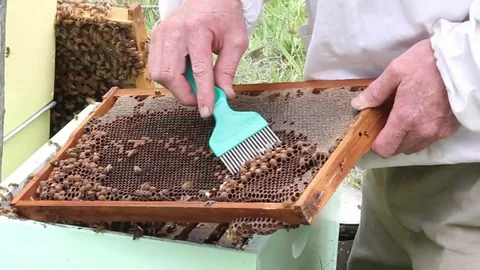As a beekeeper, one of your most important tasks is to regularly check the health of your hives. Knowing how to confirm that your beehive is alive and thriving is essential for maintaining healthy colonies. In this guide, we’ll walk you through the key signs of life in your hive and how to properly check for them, ensuring that your bees are happy and your hive is healthy. Remember to wear the best beekeeping suits and beekeeping gloves to protect yourself during inspections and ensure a safe, comfortable experience.
Key Indicators of Hive Health
To confirm that your beehive is alive, there are several key indicators to look for both inside and outside the hive. Understanding these signs will help you assess the overall health of the colony and ensure everything is functioning properly.
Signs of Active Honeybee Colonies
One of the most obvious signs that your beehive is alive is the presence of bees actively coming and going from the entrance. Bees entering the hive are typically bringing in pollen, while those exiting are foraging for nectar or defending the hive. A steady stream of bees is a positive sign that the colony is active and has enough resources to sustain itself.
Checking for Bee Movement
Even if you can’t always see bees coming and going from the entrance, it’s important to observe any movement near the hive. If the bees are relatively still, or if you notice a significant lack of activity, it might indicate that the hive is struggling. During colder months, activity may decrease, but if the hive is still alive, you should be able to spot occasional movement on warm days.
Physical Signs to Look For Inside the Hive
While bee movement outside the hive is important, it’s just as crucial to perform regular inspections of the hive itself. The interior of the hive holds some of the most important clues to the health of the colony.
Brood Patterns
One of the clearest signs of life in the hive is the presence of brood, or developing bees. A healthy colony will have eggs, larvae, and pupae in the brood cells. These patterns indicate that the queen is laying eggs and that the colony is reproducing. When checking the brood, look for evenly spaced patterns of eggs and larvae, which suggests that the queen is active and in good condition.
Honey and Nectar Stores
Another critical factor to check is the availability of honey and nectar stores. Bees store honey in the upper frames of the hive, which is vital for their survival, especially during periods of scarcity. If you find that the hive has sufficient honey stores, it’s a good sign that the colony is thriving. However, if the hive has little to no stored food, it might be time to consider feeding the bees or checking for other issues.
Capped Brood
Along with observing eggs and larvae, you should also check for capped brood. Capped brood refers to the pupae that are sealed in their cells, where they will develop into adult bees. Healthy hives typically have a mixture of brood in different stages of development, from eggs to pupae to adult bees. A strong brood pattern with abundant capped brood is a sure sign of a thriving hive.
Checking for Queen Presence
No hive is complete without a healthy, active queen. The queen is the heart of the colony, and without her, the bees will not survive for long. Checking for her presence is essential when confirming life in your beehive.
Signs of a Laying Queen
To confirm that your hive has a queen, check for eggs in the brood cells. A laying queen will deposit one egg in each cell, usually at the bottom. If you see eggs in the cells, it’s a good sign that the queen is active and healthy. A queenless hive may lack eggs or brood altogether, signaling that the colony is in trouble.
Bee Behavior Indicating Queen Health
In addition to finding eggs, you can observe the behavior of the bees inside the hive. Worker bees will typically cluster around the queen’s area, tending to her and the brood. If the bees are acting erratically or there’s a general lack of order in the hive, this might suggest that the queen is failing, and the colony could be in danger.
Identifying and Managing Hive Stress
Even a healthy hive can experience stress, which can affect its ability to thrive. It’s important to be vigilant and recognize signs of stress in your bees.
Signs of Stress or Weak Colonies
If you notice a significant decrease in bee numbers or irregular behavior from the bees, it might indicate stress. Some common causes of stress include pests, diseases, or a lack of food. In particular, a sudden drop in the number of bees or abnormal behavior, such as bees clustering outside the hive or failing to return after foraging, may signal that the colony is struggling.
Factors That Affect Hive Health
Several factors can affect the health of your hive, from pests like varroa mites to environmental conditions. Regularly inspecting for pests, monitoring for diseases, and ensuring your bees have adequate food supplies will help reduce the risk of hive stress and ensure the longevity of your colony.
Common Mistakes When Checking for Signs of Life
When performing a hive inspection, it’s easy to overlook subtle signs of life or potential issues. Here are some common mistakes to avoid:
Overlooking Subtle Signs of Life
Sometimes, the signs of life in a beehive aren’t immediately obvious. It’s important to look closely at the brood patterns, the bee behavior, and the overall condition of the hive. Small changes or irregularities can indicate underlying problems, so don’t rush your inspections.
Not Disturbing the Hive Too Much
Over-inspecting or disturbing the hive too frequently can stress the colony, so it’s important to strike a balance. Try to limit how often you open the hive, and always do so with care. Keeping the hive inspections calm and methodical will help reduce stress and allow you to observe the signs of life more effectively.
Why Regular Hive Inspections Are Essential
Regular hive inspections are a cornerstone of successful beekeeping. By checking for signs of life and managing the overall health of your hive, you can catch potential issues early and take action to correct them before they become serious problems.
Preventing Colony Collapse
Performing regular inspections is key to preventing colony collapse. Early detection of signs like a queenless hive or dwindling brood patterns can help you address issues before they become fatal for the colony. By staying on top of hive health, you’ll ensure your bees remain strong and productive.
Long-Term Hive Management
Long-term success as a beekeeper relies on consistent hive management. Keeping detailed records of your hive inspections, noting changes in bee activity, brood patterns, and food stores, will allow you to monitor trends over time and make informed decisions about your colony’s care.









